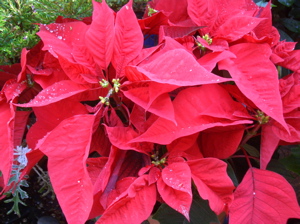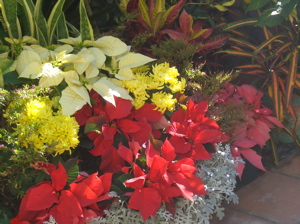poinsettia (euphorbia pulcherrima)
 These beautiful plants really have become one of the symbols of Christmas and make great gifts. The poinsettia with its large, scarlet flower heads has been cultivated over the years into bushier varieties of reds, pinks and creamy whites which are much less delicate to grow than their predecessors. In this area many of the varieties we buy are from the Paul Ecke Ranch in Encinitas, California, but they were originally native to Mexico. This evergreen, semi-evergreen or deciduous shrub has coarse leaves growing on stiffly upright canes. The showy part of the plant consists of petal-like bracts; the true flowers in the center are small, yellow and inconspicuous. The red single form is the most common, as shown here, the pinks, yellow-whites and marbled shades are less common (I even saw a blue dyed one the other day). The milky sap is not poisonous, however, some people may find it mildly irritating to skin or stomach. When buying a plant, look at the true flowers in the center - they should be unopened for maximum flower life. Also, the plant should not have been standing in a cold part of the store or outside in the cold. If you intend to keep the plant indoors, place it in a well-lit spot away from draughts and keep it reasonably warm. Surround the pot with most peat if you can, and avoid overwatering.
These beautiful plants really have become one of the symbols of Christmas and make great gifts. The poinsettia with its large, scarlet flower heads has been cultivated over the years into bushier varieties of reds, pinks and creamy whites which are much less delicate to grow than their predecessors. In this area many of the varieties we buy are from the Paul Ecke Ranch in Encinitas, California, but they were originally native to Mexico. This evergreen, semi-evergreen or deciduous shrub has coarse leaves growing on stiffly upright canes. The showy part of the plant consists of petal-like bracts; the true flowers in the center are small, yellow and inconspicuous. The red single form is the most common, as shown here, the pinks, yellow-whites and marbled shades are less common (I even saw a blue dyed one the other day). The milky sap is not poisonous, however, some people may find it mildly irritating to skin or stomach. When buying a plant, look at the true flowers in the center - they should be unopened for maximum flower life. Also, the plant should not have been standing in a cold part of the store or outside in the cold. If you intend to keep the plant indoors, place it in a well-lit spot away from draughts and keep it reasonably warm. Surround the pot with most peat if you can, and avoid overwatering. Here in Southern California, poinsettias can be grown successfully outdoors and look beautiful with colored foliage plants and brightly colored flowers. Once adapted outdoors, they need no special care, but they like well-drained soil, and full sun with some shelter. To improve the red color, you can feed them every two weeks with a high-nitrogen fertilizer, starting when the color begins to show. An interesting book to look at is Poinsettias: Myth & Legend ~ History & Botanical Fact
Here in Southern California, poinsettias can be grown successfully outdoors and look beautiful with colored foliage plants and brightly colored flowers. Once adapted outdoors, they need no special care, but they like well-drained soil, and full sun with some shelter. To improve the red color, you can feed them every two weeks with a high-nitrogen fertilizer, starting when the color begins to show. An interesting book to look at is Poinsettias: Myth & Legend ~ History & Botanical FactPoinsettia Facts
- Bloom Time: Natural bloom time is winter through spring; usually they are cultivated to bloom at Christmas time.
- Exposure: Maximum light during winter; protect from hot summer sun if plant is to be kept for next Christmas (a fairly difficult task!).
- Temperature: Average warmth; not less than 55 - 60 deg F during the flowering season.
- Air Humidity: Mist leaves regularly during flowering season.
- Care After Flowering: Plant should probably be discarded, but if you like a challenge it can be kept and will bloom again next Christmas. The lighting will have to be carefully controlled in the fall by moving it to a darkened closet for 14 hours each night, then moving it to light for a maximum of 10 hours every day. This process should be continued for 10 weeks.
1. Loss of flower heads: leaf margins yellow or brown. The usual reason is dry air in a warm room. Poinsettias need moist air - mist leaves frequently.
2. Insects. Red spider mite and mealy bug are the main pests. Both can be treated with insecticide.
3. Loss of Leaves following wilting. Overwatering is the likely cause. The surface of the compost must be dry before water is applied. Of course, failure to water when the compost around the roots is dry will also cause leaves to wilt and fall.
4. Loss of Leaves without Wilting. If the temperature is too low or if the plant has been subjected to hot or freezing draughts, then the leaves will suddenly fall. Another cause of leaf fall is poor light.



0 Comments:
Post a Comment
<< Home